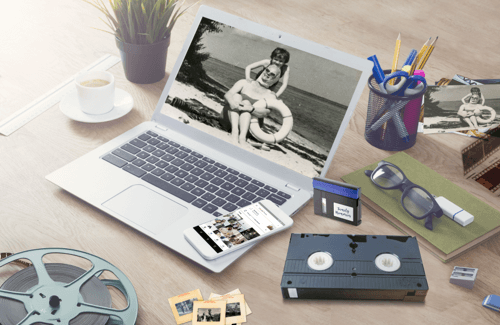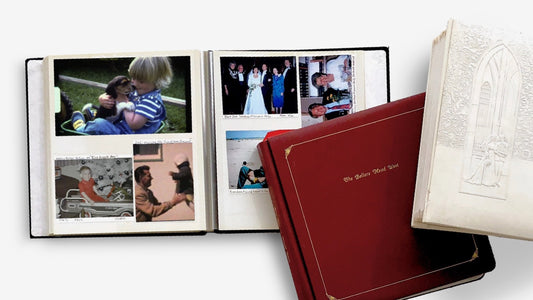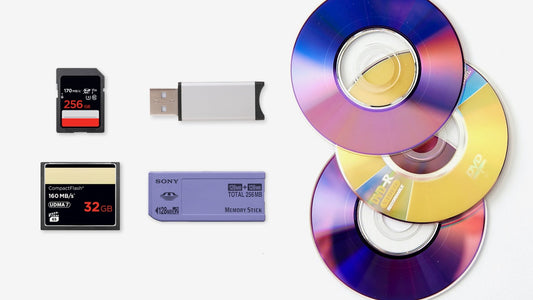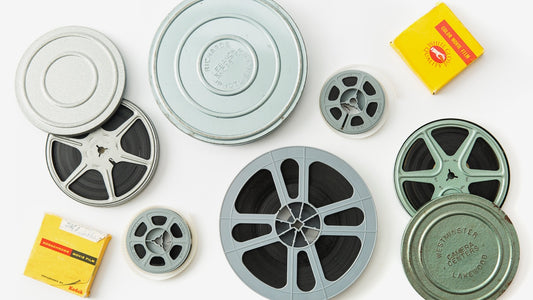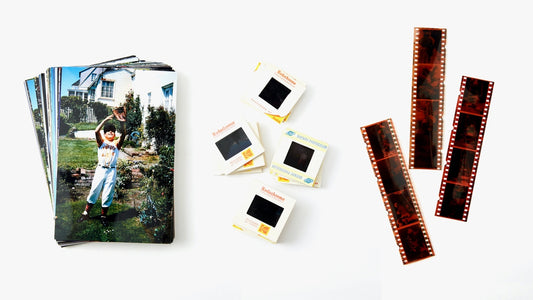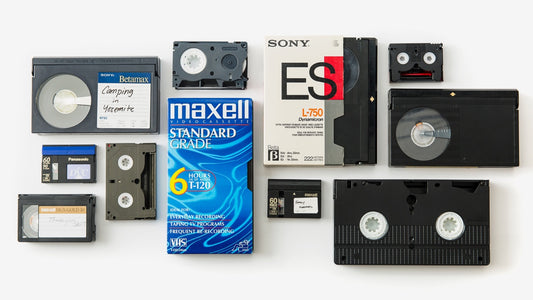That box of old film reels sitting in your closet holds more than just celluloid; it contains birthdays, holidays, and the faces of people you love. You’ve probably thought about doing something with them for years, but the project can feel overwhelming. Where do you even start? One of the first questions that comes to mind for most people is about the cost to digitize film reels. It’s a practical concern for an emotional project. This guide is here to demystify the pricing and show you what goes into the process, so you can feel confident about preserving those irreplaceable moments for your family to enjoy.
Key Takeaways
- Identify Your Film to Budget Accurately: Before getting a quote, figure out your film's format (8mm, Super 8, 16mm) and how many reels you have. Knowing the length and condition of your film is the first step to understanding the costs and comparing services fairly.
- Prioritize Quality Over a Bargain Price: The cheapest service isn't always the best for irreplaceable memories. A reputable company invests in high-quality, frame-by-frame scanning and employs experienced technicians, which ensures a clearer final video and the safe handling of your original reels.
- Create a Simple Backup System for Your Digital Files: Once your films are digitized, protect them by keeping at least two copies. Store one on a physical device like a USB or external hard drive, and keep another in a secure cloud service for easy sharing and peace of mind.
What Are the Different Film Reel Formats?
Before you can get an accurate price for digitizing your home movies, you need to know a little bit about what you’re working with. The type of film you have, its current condition, and how you decide to convert it all play a role in the final cost. Taking a moment to understand these factors will help you make the best choice for preserving your family’s memories.
Identify Your Film Type
First things first, let’s figure out what kind of film you have. Most home movies were shot on one of three main formats: 8mm, Super 8, or 16mm. You can often tell them apart by the size of the reel and the small sprocket holes along the edge of the film. 8mm and Super 8 are the most common for family collections, while 16mm was often used by more serious hobbyists. Knowing your format is the first step in getting a quote for a professional film transfer. If you’re not sure, don’t worry—a good digitization service can easily identify them for you.
How to Assess Your Film's Quality
The condition of your original film reels directly impacts the quality of your final digital videos. Over the decades, film can become brittle, warped, or even grow mold. You might also notice a distinct vinegar-like smell, which is a sign of chemical decay. While professionals have tools to clean and repair minor damage, the quality of the digital copy ultimately depends on how well the original film has held up. Even if your films aren't in pristine condition, digitizing them is the best way to halt any further deterioration and safeguard the precious moments they contain for the future.
Should You Digitize Film Yourself or Hire a Pro?
It can be tempting to try a DIY approach to save money, but this route often comes with hidden costs and technical frustrations. Home film scanners can be slow, produce inconsistent, lower-quality results, and even risk damaging your delicate, decades-old film. When you send your memories to a professional service, you’re paying for expertise and peace of mind. Technicians use specialized, high-end equipment to carefully clean and capture each frame, ensuring the best possible digital version. For something as irreplaceable as your family’s history, letting an expert handle the conversion is the safest and most reliable option.
What Goes Into the Price of Digitizing Film?
When you decide to digitize your family’s old film reels, you’re not just paying for a service; you’re investing in preserving your history. The price you see reflects the detailed, hands-on work required to safely convert your delicate memories into a format you can enjoy for years to come. Several key factors influence the final cost, from the physical characteristics of your film to the expertise of the technicians handling it.
Understanding these elements can help you see why one service might charge more than another and what you’re truly getting for your money. It’s about more than just running film through a machine. The process involves careful preparation, high-quality equipment, and the skill to bring your old footage back to life. Let’s break down exactly what goes into the pricing so you can make an informed choice for your precious memories.
Film Length and Type
The most direct factor in the cost of your project is the amount of film you have. Most services price their work based on the length of the film, typically by the foot. A small, three-inch reel holds about 50 feet of film, while a larger seven-inch reel can hold up to 400 feet. The more footage you have, the more time and resources it takes to digitize, which is reflected in the price. The type of film—like 8mm, Super 8, or 16mm—can also play a role, as each format requires specific equipment and handling procedures for a successful film transfer.
The Quality of the Equipment
Not all digitization equipment is created equal. The quality of the final digital video is heavily dependent on the technology used for the transfer. Professional services invest in high-end, frame-by-frame scanners that capture a crisp, stable, and high-resolution image from each individual frame of your film. This is a world away from cheaper methods that essentially just project the film and re-record it with a video camera. While using top-tier equipment may increase the price, it ensures your memories are preserved with the best possible clarity and color, preventing the flickering and distortion common with lower-quality transfers.
The Condition of Your Film
Your film reels have likely been sitting in storage for decades, and time can take its toll. The physical condition of your film is a major factor in the digitization process. Reels that are brittle, warped, moldy, or have weak splices require special attention before they can be safely scanned. Technicians may need to spend time carefully cleaning, repairing, and re-splicing the film by hand. This necessary prep work ensures the film can run smoothly through the scanner without being damaged, but the extra labor involved can add to the overall cost of the project.
A Company's Expertise
Digitizing film is a craft that requires a human touch. You’re paying for the experience of the technicians who will be handling your one-of-a-kind memories. An experienced professional knows how to identify potential issues with old film, make necessary repairs, and calibrate the equipment to get the best results from your specific reels. A company with a long history of digitizing home movies has developed a trusted process and has a team that knows how to manage everything from faded color to delicate film stock. This expertise provides peace of mind that your irreplaceable memories are in capable and careful hands.
Optional Add-Ons and Services
A basic digitization service will give you a digital file of your film, but many companies offer additional services to enhance your final product. These optional add-ons can include things like color correction to restore faded vibrancy, audio transfer for film with sound, or creating extra copies on DVDs or USB drives. You might also have the choice of different digital file formats or cloud storage options for easy sharing. While these services will increase the final price, they can be well worth it for creating a polished, accessible, and shareable version of your family’s history.
How Digitization Services Price Their Work
Understanding the cost of digitizing your film reels can feel a bit like solving a puzzle. Different companies have different pricing models, and it’s not always an apples-to-apples comparison. The final price tag depends on a mix of factors, including the type and length of your film, the delivery format you choose, and any extra services you might need. Think of it less as a flat fee and more as a custom quote tailored to your specific collection of memories.
Most services start with a base price and then add costs for optional features. For example, the initial quote might cover a standard-definition transfer to a DVD, but you might pay more for a high-definition scan delivered on a USB drive. Some companies charge by the foot of film, while others charge per reel. It’s helpful to have a rough idea of what you have—the format, the size of the reels—before you start shopping around. This will help you get a more accurate estimate and avoid surprises later. Let’s break down the common components that make up the total cost.
Base Price Per Film Type
The first thing most digitization services look at is the type of film you have. Common home movie formats like 8mm, Super 8, and 16mm often have different pricing structures. Some companies, like ScanCafe, charge by the foot, with a set price of around 28 cents per foot regardless of the film type. Others might charge a flat rate per reel, which can be simpler if you’re not sure how much footage you have. Before you commit, find out how a company calculates its base price for film transfer so you can accurately compare it with others.
Discounts for Large Orders
If you have a big box of film reels waiting to be digitized, you might be in luck. Many companies offer volume discounts, meaning the price per reel or per foot goes down as your order size goes up. For instance, a service like Just8mm has a pricing model that rewards larger orders. This is a great incentive to gather all your family’s films and get them done in one go. Not only does it save you money, but it also ensures your entire collection is preserved at the same time. It’s always worth asking if a company provides a discount for bulk orders.
Your Digital Format and Storage Choices
How you want to receive your newly digitized memories also plays a role in the final cost. You’ll typically have a few options to choose from. Many people opt for a physical format like a custom DVD or a USB thumb drive, which makes it easy to plug into a TV or computer. Alternatively, you can get your files through a cloud service, giving you instant access to download and share them. As Legacybox notes, these choices—thumb drive, cloud, or DVD—can affect the price, so consider how you plan to watch and store your movies when making your decision.
The Cost of Transferring Audio
Did your old home movies have sound? While many 8mm and Super 8 films were silent, some formats included a magnetic strip for audio. Transferring this sound often comes with an additional fee. For example, some services charge around $5 extra per reel to capture the audio track along with the video. If you know your films have sound, make sure to check if audio transfer is included in the base price or if it’s considered an add-on service. This is a small detail that can make a big difference in reliving the full memory.
How to Spot Hidden Fees
No one likes surprise charges. The best digitization services are transparent about their pricing from the start. A trustworthy company is upfront about its prices and has no surprise fees. When comparing services, keep an eye out for potential hidden costs. These could include setup fees, charges for cleaning or repairing film, or extra costs for specific file formats. Don’t hesitate to ask for a detailed breakdown of the quote to ensure the price you see is the price you’ll pay.
What Happens When You Send Your Film to a Pro?
Handing over your family’s film reels can feel like a leap of faith. You’re trusting someone with irreplaceable memories, and it’s natural to wonder what happens to them once they leave your hands. Understanding the meticulous, hands-on process that professionals use can give you peace of mind. This isn’t an automated, assembly-line operation. From the moment your films arrive, they are treated with the care and attention they deserve by trained technicians. Here’s a step-by-step look at how your memories make the journey from analog to digital.
Step 1: Initial Inspection
The first thing a technician does is a thorough inspection of your film reels. They’re not just checking a box off a list; they’re carefully examining each reel by hand to assess its condition. This initial check looks for any potential issues that could affect the transfer, like mold, brittleness, or other signs of decay. They’ll also identify the specific film format to ensure the right equipment is used. This careful evaluation is a crucial first step in a professional film transfer service, as it sets the stage for a successful digitization and ensures any problems are flagged right from the start.
Step 2: Cleaning and Prep Work
Once your film passes inspection, it moves on to the prep station. Over the years, film can collect dust, oils, and grime that will show up on the final digital version if not properly cleaned. Technicians use special equipment and gentle cleaning agents to carefully remove this buildup without damaging the delicate film. They’ll also perform minor repairs, like fixing old, broken splices that could cause the film to jam during the transfer. This preparation is essential for getting the clearest and most stable picture possible, ensuring your memories look their best before the real magic begins.
Step 3: The Transfer Process
This is where the transformation happens. Instead of just projecting the film onto a screen and recording it, professionals use high-end equipment to scan your film frame by frame. This method captures a high-resolution digital image of every single frame on your reel. It’s a detailed and time-consuming process, but it’s the best way to preserve the original quality, color, and detail of your home movies. This frame-by-frame approach ensures a flicker-free, stable video that you can enjoy for years to come, creating a true digital master copy of your original film.
Step 4: Quality Checks
A professional service doesn’t just set the machine and walk away. After the initial transfer, the digital files go through a quality control process. Technicians review the footage to check for consistency in color, brightness, and clarity. They ensure the entire film was captured correctly and that the final product meets their high standards. At YesVideo, every order is processed by hand right here in the USA, and you receive updates throughout the process. This human oversight is key to catching any issues and delivering a final product that your family will cherish.
Step 5: Receiving Your Digital Files
After your film has been digitized and reviewed, the final step is delivering your new digital keepsakes. You’ll typically have several options for how you want to receive your files. You can get them on a convenient thumb drive, as a digital download from a secure cloud service, or on DVDs. Your original film reels are, of course, carefully packed up and sent back to you along with your new digital copies. This flexibility allows you to easily watch, share, and preserve your memories on modern devices, from your computer to your smart TV.
How to Choose the Right Digitization Service
Handing over a box of your family’s most precious memories can feel like a huge leap of faith. You’re not just sending off old film reels; you’re entrusting someone with irreplaceable moments. That’s why picking the right digitization service is so important. It’s about more than just getting a digital file—it’s about finding a partner you can trust to handle your memories with the care they deserve.
When you start looking at different companies, you’ll see a lot of options and varying prices. To make a confident choice, you need to know what to look for. Think about the provider’s experience, what guarantees they offer, how long the process will take, and what their quality standards are. Understanding these key areas will help you find a service that not only fits your budget but also gives you peace of mind. Let’s walk through what you should consider.
What to Look For in a Provider
When comparing services, start with the company’s reputation and experience. How long have they been in business? Do they specialize in the type of film you have? Look for customer reviews and testimonials to get a sense of other people’s experiences. The most significant factor in determining cost is often the length of the film you're transferring, so look for a provider with clear, upfront pricing based on format and length. A trustworthy company will be transparent about their film transfer process and what you can expect every step of the way. They should make it easy to understand how they’ll care for your originals from start to finish.
Check for Service Guarantees
Peace of mind is priceless, so see what kind of guarantees a company offers. Do they have a satisfaction guarantee? What about a promise for the safe handling of your original media? Some services, for example, process every order by hand in the USA to ensure quality and security. It’s also important to understand what’s included in the final price. Some companies include cloud storage and a digital download, while others may charge extra for these. Clarifying these details upfront ensures there are no surprises and that your memories are protected throughout the process. A solid guarantee shows that a company stands behind its work.
Ask About the Turnaround Time
Digitizing film properly takes time, so it’s good to have realistic expectations. The entire process, from when you send your film in to when you get your originals and digital copies back, can take several weeks. A typical order often takes about 3-4 weeks. This timeline allows technicians to carefully inspect, clean, and repair your film before the transfer even begins. Reputable companies won’t rush this delicate work. Always check the company’s website for their current estimated turnaround time, as it can vary, especially during busy holiday seasons. A little patience goes a long way toward getting a high-quality result.
Understand Their Quality Standards
The quality of the final digital files depends heavily on the equipment and expertise of the service provider. High-end scanners and professional-grade software make a world of difference in capturing the clarity and color of your original films. A good service will perform frame-by-frame scanning to ensure every moment is captured in high resolution. Don’t be afraid to ask about the technology they use. A company that invests in quality equipment is invested in delivering a quality product, whether it's a video transfer or a complex film project. This commitment to quality is what separates an okay result from a great one.
Tips for Comparing Prices
When it comes to preserving memories, the cheapest option isn’t always the best. Pricing that seems too good to be true might signal low-quality results or hidden fees that pop up later. Look for a company with a straightforward pricing structure. Compare what’s included in the base price—does it cover cleaning, repairs, and your choice of digital format? Some services might charge extra for things you assume are standard. By comparing the total cost and the services included, you can find a provider that offers great value and results you’ll cherish for years to come.
Optional Services That Are Worth the Cost
When you decide to digitize your film reels, the main goal is to get them into a modern, watchable format. But most professional services offer a few extra options that can take your home movies from simply preserved to beautifully restored. Think of these as the finishing touches that make a world of difference. While the standard film transfer process is fantastic, these add-ons are designed to tackle the specific ways that film ages over time—faded colors, muffled sound, and physical wear and tear.
You don’t need to spring for every available service, but understanding what they do can help you decide which ones are worth the investment for your specific collection. If your films have been stored in less-than-ideal conditions or are several decades old, these services can be especially valuable. They help ensure the final digital version is as clear, vibrant, and enjoyable as possible, letting you focus on the memories themselves, not the imperfections of the old media.
Color Correction
Over the years, the chemicals in film break down, often causing colors to fade or shift. You might notice your footage has a blue or reddish tint, or that the once-vibrant colors now look washed out. Color correction is the process of digitally adjusting the footage to bring those colors back to life. It restores the balance, making skies blue again, grass green, and skin tones look natural and warm. This single step can have the biggest visual impact on your digitized films, making them feel less like an old recording and more like a window into the past.
Audio Enhancement
If your film reels have a sound strip, you know that the audio quality can be a mixed bag. Time can degrade the magnetic strip, resulting in muffled dialogue, background hiss, or distracting static. Audio enhancement services clean this up by reducing unwanted noise and clarifying the sounds you actually want to hear. This is incredibly valuable for home movies where conversations, laughter, or a child’s first words were captured. It can be the difference between watching a silent movie and truly reliving a moment by hearing the voices of your loved ones clearly.
Digital Restoration
Film is a physical medium, and it’s susceptible to damage over time. Scratches, dust, and small tears are common issues that can show up as distracting lines or spots on your screen when the film is played. Digital restoration is a meticulous process that helps repair this damage. Technicians can digitally remove many of these imperfections, resulting in a much cleaner and smoother viewing experience. This service is particularly worth it for reels that are especially precious or show visible signs of wear, ensuring the focus stays on your family’s story.
Getting Multiple Digital Formats
Once your film is digitized, you’ll need to decide how you want to receive the files. While a single format is fine, opting for multiple delivery methods offers a great deal of flexibility and security. For example, you could get your memories on a USB drive for a tangible backup you can store safely, and also get access to them via the cloud. A cloud link is perfect for instantly sharing memories with family members, no matter where they live. This approach ensures your memories are both safely backed up and easy to enjoy and distribute.
How to Protect Your New Digital Memories
Once your film reels are digitized, the preservation work isn't quite over. You've successfully stopped the clock on physical decay, but now you need a plan to keep your digital files safe for generations to come. Unlike a dusty box of reels in the attic, digital memories don't degrade from heat or moisture, but they can be lost to a hard drive failure or an accidental deletion.
The great news is that protecting your digital memories is straightforward. With a few simple steps, you can ensure these precious moments are secure, accessible, and easy to share with the entire family. It’s all about creating a system that doesn’t rely on a single device or location. By building in a little redundancy, you’re giving your family’s history the security it deserves, making sure it can be enjoyed for years without any worry.
Create a Backup Plan
The golden rule of digital preservation is to never keep your memories in only one place. Technology can be unpredictable, so having multiple copies is your best defense against loss. A great strategy is to keep at least two copies: one physical copy you control and one copy in the cloud. For your physical backup, an external hard drive is an excellent choice. For your cloud backup, you can use a service like Google Drive, Dropbox, or iCloud. This approach ensures that if your computer crashes or your external drive fails, you still have a secure copy stored safely online.
Where to Store Your Files
When you get your digitized memories back, you have a few great options for storage. YesVideo offers a USB drive, which is a fantastic, tangible way to keep your files. You can plug it into a computer or smart TV to watch your home movies instantly. Another option is cloud storage, which makes sharing with family members a breeze. With a simple link, relatives across the country can view and download the files. For a truly robust plan, use both. Keep the original files on a dedicated external hard drive and upload a second copy to a trusted cloud storage service.
Best Practices for Digital Preservation
A little organization goes a long way. Instead of leaving your files with generic names like "Movie_01.mp4," take a few minutes to rename them with the date and event (e.g., "1985_Christmas_Morning.mp4"). Create folders for different years or family branches to make everything easy to find. Share your organized library with key family members. When multiple people have copies, it creates a natural backup system. This also fulfills one of the best parts of any photo transfer project: bringing everyone together to relive cherished moments.
How to Future-Proof Your Memories
Technology is always changing. Remember floppy disks and CDs? To ensure your memories remain accessible, it’s wise to stick with standard, universal file formats like MP4 for video and JPG for photos. These are the most widely supported formats and are unlikely to become obsolete anytime soon. It’s also a good practice to check on your files every few years. You might decide to move them to a new, larger external hard drive or a different cloud service. This simple digital check-up ensures your film transfer was an investment that truly lasts a lifetime.
How to Budget for Your Film Digitization Project
Figuring out the budget for your film digitization project doesn't have to be complicated. It’s all about knowing what to expect and making choices that feel right for you and your precious memories. The goal is to find a service that respects your films as much as you do, without any surprise costs along the way. By thinking through a few key areas—like the balance between quality and price, planning ahead, and understanding the long-term benefits—you can create a budget that works for you. This approach helps you confidently invest in preserving your family’s history for everyone to enjoy for years to come.
Balance Quality and Cost
When it comes to digitizing your family films, the cheapest option isn't always the best. The price of a film transfer service often reflects the quality of the equipment and the expertise of the technicians handling your memories. Higher-quality scanners and professional processes result in a clearer, more vibrant digital copy that truly captures the original moment. Think of it as an investment. Spending a little more upfront for a reputable service can mean the difference between a fuzzy, discolored video and a beautifully preserved memory you’ll be proud to share. It’s about finding that sweet spot where you feel good about both the price and the quality of the final product.
Plan Your Project in Advance
A little planning can go a long way in creating an accurate budget and avoiding unexpected fees. Before you even start looking for a service, take some time to gather all your film reels. Figure out what you have—are they 8mm, Super 8, or 16mm? How many reels are there, and what are their sizes? Having a clear inventory helps you get a precise quote. As the Chicago Film Archives points out, pricing depends on multiple factors, so knowing the scope of your project is the best first step. This preparation makes the whole process smoother and ensures your budget is based on the actual work required.
Simple Ways to Save Money
If you're working with a tight budget, there are still ways to make your digitization project more affordable. One of the biggest factors influencing cost is the total length of your footage. Take a look at your collection and decide which reels are the most important to you. You might choose to digitize the highlights first—like weddings, birthdays, and holidays—and save others for later. You can also look for companies that offer discounts for larger orders. By bundling all your films into one project, you might get a better price per reel than if you sent them in small batches over time.
Think About the Long-Term Value
Finally, try to frame the cost as more than just a one-time expense. You're investing in the security and longevity of your family’s legacy. Physical film reels degrade over time, but digital files can be backed up and shared endlessly without losing quality. The ability to instantly send a clip of your parents’ wedding to a cousin across the country or watch your own childhood birthday parties with your kids is priceless. Digitizing your home movies protects them from being lost forever and makes them accessible for future generations to enjoy. That peace of mind is the real return on your investment.
Related Articles
- 8mm Film Digital: Your Complete Guide for 2025 – YesVideo
- Film Transfer – YesVideo
- YesVideo's Film Transfer - Transfer Old Film Reels to Digital
- Film Transfer Service Guide
Frequently Asked Questions
I have a box of old reels, but I have no idea what kind of film they are. Can I still get them digitized? Absolutely. This is a very common situation, so don't worry about it. Any professional service worth its salt can easily identify the film format for you once it arrives at their facility. Technicians are trained to recognize 8mm, Super 8, 16mm, and other formats and will use the correct equipment to handle your specific reels. The initial inspection process is designed to figure out exactly what you have and what condition it's in.
My films smell like vinegar and look brittle. Are they too damaged to be saved? That distinct vinegar smell is a sign that the film is beginning to break down chemically, which is why now is the perfect time to act. While severe damage can affect the final quality, it's rare for film to be completely unsalvageable. In fact, digitizing is the single best thing you can do to stop any further decay in its tracks. Professionals have experience handling delicate film and can often clean and repair it enough to get a stable transfer, preserving those memories before they're lost for good.
Why is professional digitization more expensive than just buying a home scanner? It really comes down to quality and safety. Home scanners are often slow, can produce flickering, low-resolution results, and their mechanisms can easily jam or even tear delicate, old film. When you use a professional service, you're paying for experienced technicians to handle your irreplaceable memories, high-end equipment that scans each frame individually for the best clarity, and the peace of mind that comes with a secure, trusted process. It’s an investment in doing it right the first time.
What's the best way to receive my digitized movies—a USB, DVD, or cloud download? The best choice depends on how you plan to use your movies. A USB drive is a fantastic physical backup that you can easily plug into a computer or smart TV. A cloud download is the fastest way to get your files and makes sharing them with family and friends incredibly simple with just a link. Many people find that a combination of the two is the perfect solution, giving you a tangible copy for safekeeping and the instant accessibility of the cloud.
I'm worried about my original reels getting lost or damaged. How do you keep them safe? Your concern is completely valid, as these memories are irreplaceable. Trustworthy companies have a meticulous, hands-on process to protect your originals from the moment they arrive. Every order is carefully tracked and handled by technicians, not just run through an automated system. Choosing a service that processes everything in the USA, like YesVideo, adds another layer of security. Your original reels are always returned to you along with your new digital copies.





